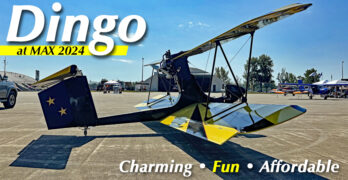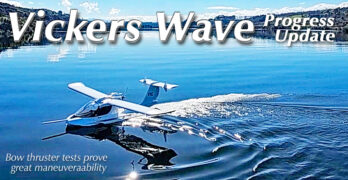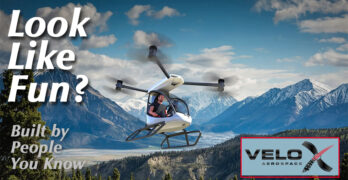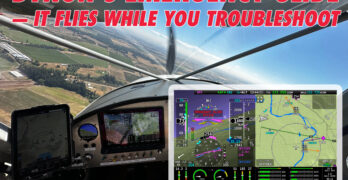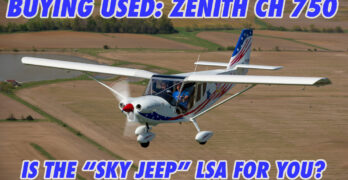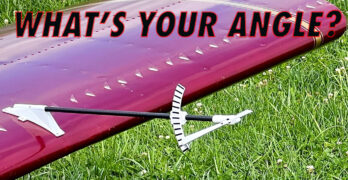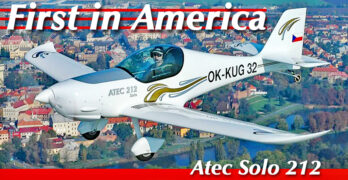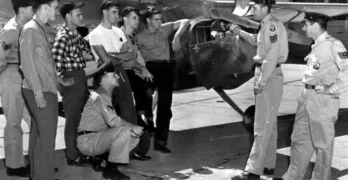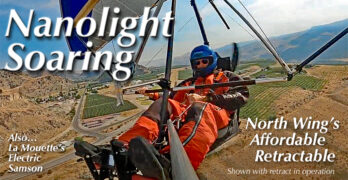If you look at Dingo and smile, you may be an ultralighter. Appearance and qualities about Future Vehicles‘ single seat bi-wing flying machine attract certain pilots like bees to a bright flower.
If you must have two seats, large flat screen displays, an autopilot, and luxurious appointments, you probably are not attracted to Dingo. Fine. The good news is that you’ll have plenty of choices among Mosaic LSA.
Those of us still smiling at the nearby images might already be captivated. If you are caught by Dingo’s interesting specs and its affordability, you might want to learn more. So, here’s more…
Dingo Is for Fun
Shown to Americans for the first time at MAX 2024 (Midwest Aviation Expo) by Bluff City Aircraft, Dingo drew steady interest from the fun flying crowd. For a grin-producing flight at the end of your workday, Dingo might be just about perfect.
Search Results for : Flight Design
Not finding exactly what you expected? Try our advanced search option.
Select a manufacturer to go straight to all our content about that manufacturer.
Select an aircraft model to go straight to all our content about that model.
Changing LSA Seaplane Market — Vickers Wave Progress Update — Others, Hmmm…?
Winter is coming, so naturally, it’s time to start thinking about seaplanes… right? It always seems weird to write about water-based activities as frost begins to envelop the northern two-thirds of the country. Yet winter is when all the big boat shows happen because buying new vessels requires advance planning. It’s also pleasant to think about spring and summer while snow flurries fly.
For many years I’ve written about this sector and names like Searey, Seamax, and Aventura (all in nearby image) have long been the leading brands. Now the first two are in financial trouble and the last has decamped to Brazil from Florida. Whatever is going on, Vickers Wave may represent a breath of fresh air.
In articles last fall and this spring, I gave overviews of the entire LSA seaplane market (read here or here).
Vickers Wave Update
Vickers previously noted, “Wave has finished its flight testing, resulting in a 120-knot cruise and useful load of 750 pounds powered by a Rotax 916iS (reviewed here).”
“A frequently asked question I receive is, ‘What is taking so long?’,” begins Paul Vickers.
Higher Flyer: The WT9 Dynamic Turbo
Lined up on the runway, I open the throttle to the stop. The Dynamic surges forward, my right thumb presses a small button at the base of the throttle quadrant and I push the lever further forward. In an instant there’s 15% more thrust and the speed tape really starts to roll. Ease back on the stick and we’re airborne after a very short ground roll and climbing away at well over 1200 fpm.
Flaps up, and 20 seconds later we’re passing through 400 feet, I pull the power back past the detent and the turbocharger control unit (TCU) reduces boost to 35 inches of manifold pressure. I then lower the nose, dial the prop rpm down to 5500 engine rpm and note the VSI is still showing around 1000 fpm before swinging the shapely spinner onto a south-easterly heading. Already I can see that the field of view is phenomenal and feel that the handling is crisp and taut.
A Multicopter Current Pilots Might Enjoy? …Developed Within Our LSA Industry
Here’s a helicopter-like aircraft you might actually consider. I have often reviewed what I call multicopters (several articles). I searched for aircraft you might fly for fun; several of them can enjoy the freedom and special benefits of Part 103. I’ve stayed away from commercial “air taxi” projects.
But what if a longtime producer of Light-Sport Aircraft entered the space? What if the aircraft looked like a helicopter but one you could fly without the steep learning curve? What if it offered 45 minutes of flight with a 15-minute reserve?
The earliest entries had short flight times, 15-20 minutes. Most of them cost too much. For example, Opener’s Blackfly (now called Helix) was first promoted at the cost of a “luxury SUV,” perhaps meaning $80,000 at the time. It has since more than doubled in price.
You may doubt or dislike these flying machines, especially when you don’t know the people behind the projects.
Flying Dynon’s Emergency Glide Feature — Go Down Easy (UPDATED)
I probably shouldn’t admit this, but some features that come with the latest electronic flight instruments have left me a little, um, disinterested. Until I try them, that is. A good example is the concept of “safe glide” or even autoland. Garmin introduced both concepts a few years ago, though the full-autoland idea is more recent and limited to high-end aircraft where the system can control the engine directly. That’s not at my pay grade.
The more common version is what Garmin calls Smart Glide and, more recently, Dynon rolled out what it calls Emergency Glide. They work similarly: When commanded, they set up a controlled descent to the nearest viable airport and let the pilot concentrate on other things. To be honest, I was a bit meh about them as safety features. After all, you’re trained to set the airplane up for best-glide speed as soon as you recognize a power failure and all good pilots fly along considering which airports beneath them are reachable.
Buying Used — Zenith STOL CH 750, Backcountry on a Budget
Purchasing a used airplane can be risky because it’s sometimes difficult to determine whether the aircraft has been taken care of properly. Buying a used kit aircraft? Even riskier. Not only do you have to worry about wear and tear, but also whether the builder knew what they were doing. But that doesn’t mean buying one is foolish. It might allow you to find an aircraft that truly fits your needs, and possibly save you money because its home-built origin will likely reduce the price.
If you feel comfortable going this direction, then a used Zenith is worth looking at—and if you don’t, remember that Zenith has also made the CH 750 as a factory-built SLSA, of which there are currently 42 registered in the U.S. Anyway, the company has been making kits for three decades and it has a great reputation in the Light Sport world. Its STOL CH 750 model is especially popular among builders, and you can find used ones up for sale fairly often.
See This — Radiant’s Low-Coast Angle of Attack
Sometimes the simpler the better. At least that’s the philosophy James Weibe has always seemed to follow. He’s definitely embraced that approach with the new visual angle of attack (AoA) indicator. No electronics. No special pitot tube.
The Radiant AoA is a simple vane-style pointer you mount to the wing nearest you—well, because you want to see it. According to Radiant, “Our new Visual AOA provides direct visual feedback of the aircraft’s Angle Of Attack. Any pitch change or power change is immediately reflected in the indication. It is designed to mount on the leading edge of an experimental aircraft. It is available with a generic mount for the leading edge of aircraft. A top side mount for Sonex (low wing) aircraft is also available.” The instrument is easily removable to prevent skewering your next Young Eagles ride. (Mom says thanks.)
Weibe includes a demo video for your consideration.
Go Solo! Atec’s Solo 212 Let’s You Fly Yourself in Style, Yet It’s Affordable
Was this aircraft the star of MAX, the airshow? Maybe. “It drew a lot of attention,” said a company representative, “a sleek taildragger single seater with a 912 up front.” That it was accented with red inside and out helped, as proven by big auto companies that spend millions to advertise red cars when they want to catch your eye. (Updated 2/27/24: new images at bottom)
Atec Solo 212 is the name of the airplane. It will not be their top seller but for plenty of pilots (me included) this was a charmer. Plus, let me spill the beans on its affordability. I don’t know your budget but this beauty could be had, in America, for $100-110,000 reported RT Aviation partner Todd Livingston a couple weeks after MAX ’24 concluded. That price won’t work for everyone, I know, but it’s half the cost of many “reasonably” priced SLSA in fall 2024.
Flying Clubs as Another Route to Affordable Aviation
In the previous article, I explained how high levels of flight activity can make access more affordable and, for most people, how that would likely be achieved only through some form of shared ownership/use. The use of the term “shared ownership/use” is deliberate because not everybody really wants or feels the need to “own” something they use but, perhaps, believes that there is no other realistic or safe alternative.
This article is based on a close examination of the reasons people give for not being open to any form of sharing and looking at how those barriers might be removed. It will also try to address the second, less discussed, part of affordability, which is “accessibility” to shared use aircraft. There is little benefit to being able to afford what does not, essentially, exist. A good, but somewhat parallel, example of this has been the original iteration of Light Sport Aircraft and Sport Pilot Licenses.
Superlight… Aircraft that Weigh Less than You Do and Are More Affordable
My title avoided the word “ultralight” even if these two aircraft qualify. The American entry can readily fit FAA’s Part 103 as an Ultralight Vehicle, freeing the pilot from having to register the aircraft, or have a pilot certificate, or possess any sort of “medical” to fly it.
The French entry cannot qualify as a Part 103 but I find it surprising this super lightweight machine is a two seater and can be electric-powered. It is not available in the USA at this time but the brand once had a strong American presence. I owned one of their light trikes myself a couple decades back. Here’s a full review from 2004.
Welcome to brief reviews of two very light weight-shift aircraft, North Wing’s SkyMax and La Mouette’s Samson. (La Mouette is French for seagull.)
That these two are also more affordable may come to the rescue of budgets under assault by persistent inflation.
- « Previous Page
- 1
- …
- 42
- 43
- 44
- 45
- 46
- …
- 147
- Next Page »


